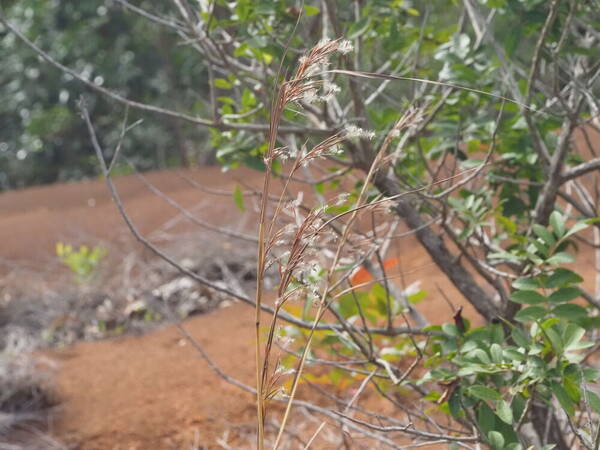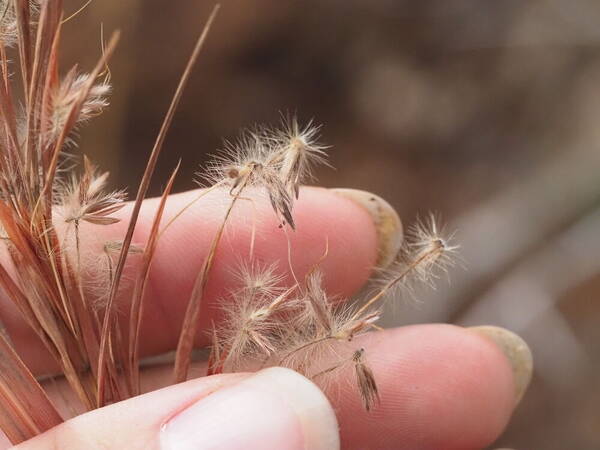Info
Subfamily: Panicoideae
Genus etymology: Hyparrhenia = "male below" [Greek] refering to the male flowers at the base of the raceme
Species etymology: dregeana = honorific for Johann Franz Drège (1794–1881)
Photosynthetic type: C4 (warm season)
Nativity: naturalized - accidental
First recorded in Hawaiʻi: 1975
Map

Inflorescence

Plant

Spikelets



Landscape

Peduncle of inflorescence

Description
Densely tufted perennial, the basal leaf-sheaths silky pubescent below; culms robust, 1.5–2 m. high or more, Leaf-blades mostly up to 60 cm. long, 3–8 mm. wide, usually harsh and glaucous but sometimes soft and green. False panicle narrow, fairly dense, 20–50 cm. long; spatheoles narrowly lanceolate, 2.5–5 cm. long, becoming reddish-brown, the peduncles from 1/2 to rather longer than the spatheole; racemes 10–25-awned per pair, densely spiculate with internodes 1.5–2 mm. long, tardily deflexed; raceme-bases subequal, the upper 1–1.5 mm. long, flattened, stiffly bearded, usually with a scarious lobe up to 0.5 mm. long at its tip. Homogamous pairs 1 at the base of the lower raceme only. Sessile spikelet 4–5.5 mm. long, densely villous to hispidulous, rarely glabrous; callus cuneate, 1 mm. long, subacute to narrowly obtuse; awn (1–)8–20(–28) mm. long. Pedicelled spikelet densely villous to hispidulous, rarely glabrous, muticous or sometimes with a brief awn-point.
(Description source: Clayton, W.D. & Renvoize, S.A. 1982. Flora of Tropical East Africa. Gramineae (Part 3). A.A. Balkema, Rotterdam. 448 pp. )
Robust, densely caespitose perennial; culms up to 200 cm high (or more) and up to 4 mm in diameter at the base, simple or scantily branched. Basal leaf sheaths silky pubescent below, otherwise all sheaths glabrous; leaf laminas up to 60 cm × 3–8 mm, flat or inrolled and narrower, glabrous, usually stiff and glaucous with scaberulous nerves and harsh to the touch, sometimes soft and green. False panicle 20–50 cm long, narrow, fairly dense; spatheoles 2.5–5 cm long, narrowly lanceolate, glabrous or thinly hirsute (rarely the whole panicle copiously villous), becoming reddish-brown; peduncles 1.5–5 cm long, from half as long as to rather longer than the spatheole, pilose above with yellowish hairs; racemes 2–3 cm long, 10–25-awned per pair, usually exserted terminally, tardily deflexed; raceme-bases subequal, the superior 1–1.5 mm long, flattened, stiffly barbate, the apex with a scarious rim and usually produced into a definite oblong appendage up to 0.5 mm long. Homogamous spikelets 5–7 mm long, a single pair at the base of the inferior raceme only, villous or rarely glabrous. Sessile spikelets 4–5 mm long; callus c. 1 mm long, cuneate, subacute to narrowly obtuse at the apex; inferior glume oblong-lanceolate, yellowish-green to light brown or purple, densely villous to hispidulous, rarely glabrous; awn (1)8–20(28) mm long, the column pubescent with tawny hairs. Pedicelled spikelets 5–6 mm long, similar to the sessile spikelets in indumentum and colouring, muticous or with a short awn-point up to 1.5 mm long at the apex; callus scarcely developed; pedicel-tooth obscure.
(Description source: Cope, T.A. (ed.). 2002. Flora Zambesiaca. Volume 10. Part 4. Kew, London. 190 pp. )
Habit: Perennial; caespitose. Butt sheaths pubescent. Culms erect; robust; 150-200 cm long; 2-4 mm diam. Leaves cauline. Ligule an eciliate membrane; 2-4 mm long. Leaf-blades 30-60 cm long; 3-8 mm wide; stiff; glaucous. Leaf-blade surface scaberulous; glabrous. Inflorescences: Synflorescence compound; paniculate; 20-50 cm long; dense. Inflorescence composed of racemes; terminal and axillary; subtended by a spatheole; exserted, or embraced at base by subtending leaf. Spatheole lanceolate; 2.5-5 cm long; membranous; brown, or red; glabrous, or hirsute. Peduncle 1.5-5 cm long; pilose above. Racemes 2; paired; deflexed; 2-3 cm long; bearing 5-13 fertile spikelets on each. Rhachis fragile at the nodes; ciliate on margins. Rhachis hairs white. Rhachis internodes linear; 1.5-2 mm long. Rhachis internode tip oblique; flat. Raceme-bases flattened; subequal; 1-1.5 mm long; stiffly setose; scariously rimmed, or extended into an oblong appendage; with 0-0.5 mm long appendage. Spikelets appressed; in pairs. Fertile spikelets sessile; 1 in the cluster. Companion sterile spikelets pedicelled; 1 in the cluster. Pedicels linear; flattened; ciliate; tip oblique. Sterile Florets: Basal sterile spikelets well-developed; on lower raceme 2 in number; 0 in upper raceme; lanceolate; 5-7 mm long; larger than fertile. Basal sterile spikelet glumes glabrous, or villous; ciliate on margins; lower glume muticous. Companion sterile spikelets well-developed; containing empty lemmas, or male; lanceolate; dorsally compressed; 5-6 mm long; longer than fertile; separately deciduous. Companion sterile spikelet glumes chartaceous; glabrous, or pubescent, or villous; acute; muticous, or mucronate, or awned; one glume awned; with 0.5-1.5 mm long awn. Companion sterile spikelet lemmas 2; enclosed by glumes. Fertile Spikelets: Spikelets comprising 1 basal sterile florets; 1 fertile florets; without rhachilla extension. Spikelets lanceolate; dorsally compressed; 4-5 mm long; falling entire; deciduous with accessory branch structures. Spikelet callus cuneate; 1 mm long; pubescent; base obtuse, or acute; attached obliquely. Glumes: Glumes dissimilar; exceeding apex of florets; firmer than fertile lemma. Lower glume lanceolate; 1 length of spikelet; coriaceous; yellow, or dark brown, or purple; without keels; keel-less except near apex. Lower glume surface glabrous, or hispidulous, or villous. Lower glume apex dentate; 2 -fid. Upper glume linear; coriaceous; without keels. Florets: Basal sterile florets barren; without significant palea. Lemma of lower sterile floret lanceolate; 1 length of fertile lemma; hyaline; 2 -veined. Fertile lemma linear; membranous; without keel; 1 -veined. Lemma apex dentate; 2 -fid; awned; 1 -awned. Principal lemma awn from a sinus; geniculate; (1-)8-20(-28) mm long overall; with twisted column. Column of lemma awn puberulous, or pubescent; with 0.2-0.4 mm long hairs. Palea absent or minute. Flowers: Lodicules 2; cuneate; fleshy. Anthers 3. Stigmas 2. Distribution: Africa: west-central tropical, northeast tropical, east tropical, southern tropical, and south. Asia-temperate: Arabia. Pacific: north-central.
(Description source: Clayton, W.D., Vorontsova, M.S., Harman, K.T. and Williamson, H. (2006 onwards). GrassBase - The Online World Grass Flora. Available at https://powo.science.kew.org )